Small overlap front: driver-side
Rating applies to 2013-16 models
Tested vehicle: 2013 Ford Escape SE 4-door 4wd
The Ford Escape was redesigned for the 2013 model year.
| Evaluation criteria | Rating |
|---|---|
| Structure and safety cage | |
| Driver injury measures | |
| Head/neck | |
| Chest | |
| Hip/thigh | |
| Lower leg/foot | |
| Driver restraints and dummy kinematics The dummy’s head barely contacted the frontal airbag before sliding off the left side as the steering column moved to the right, leaving the head vulnerable to contact with forward side structure. Additionally, the seat belt allowed excessive forward excursion of the dummy’s head and torso. The side curtain airbag deployed but does not have sufficient forward coverage to protect the head from contact with forward side structure and outside objects. | |

Action shot taken during the small overlap frontal crash test.
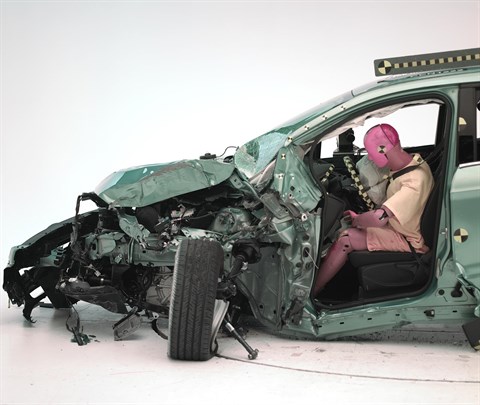
The dummy's position in relation to the door frame, steering wheel, and instrument panel after the crash test indicates that the driver's survival space was not maintained well.
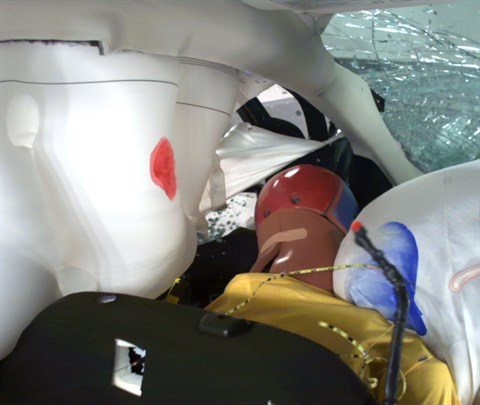
During the crash, the dummy's head barely contacted the airbag before sliding off to the left, and the seat belt allowed the dummy to move too far forward, as is evident from the gap between the seat back and the dummy's torso. The side curtain airbag did not extend far enough forward toward the A-pillar.
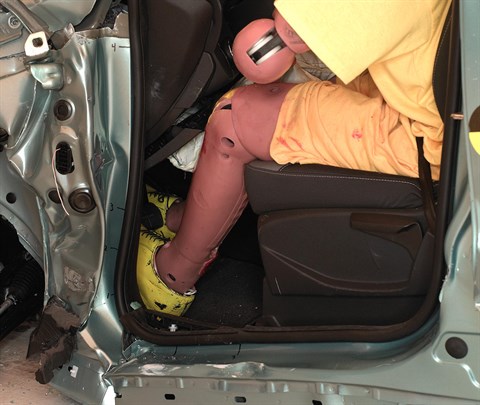
Door hinge pillar and instrument panel intrusion was extensive and contributed to a high risk of injury to the left hip and a moderate risk of injuries to the left and right lower legs.
Small overlap front: passenger-side
Rating applies to 2013-19 models
Tested vehicle: 2018 Ford Escape SE 4-door 4wd
The Ford Escape was redesigned for the 2013 model year. Although Ford reinforced the structure starting with the 2017 model year on the driver side to improve occupant protection in small overlap frontal crashes, no such changes were made on the passenger side.
| Evaluation criteria | Rating |
|---|---|
| Overall evaluation | |
| Structure and safety cage | |
| Passenger injury measures | |
| Head/neck | |
| Chest | |
| Hip/thigh | |
| Lower leg/foot | |
| Passenger restraints and dummy kinematics The dummy’s head contacted the frontal airbag but then rolled around the right side. The side curtain airbag did not deploy, leaving the dummy's head vulnerable to contact with side structure and outside objects. | |
| Driver injury measures | |
| Head/neck | |
| Chest | |
| Hip/thigh | |
| Lower leg/foot | |
| Driver restraints and dummy kinematics | |
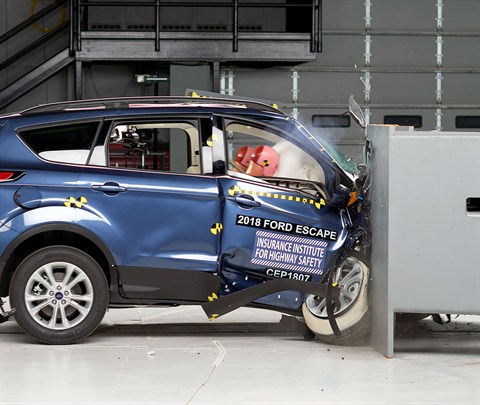
Action shot taken during the passenger-side small overlap frontal crash test.

The dummy's position in relation to the door frame and dashboard after the crash test indicates that the passenger's survival space was not maintained well.
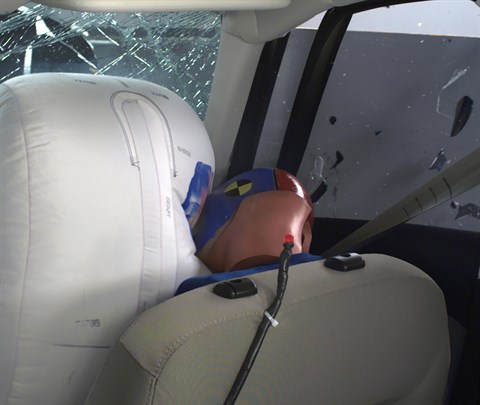
The dummy's head contacted the frontal airbag but then rolled around to the right. The side curtain airbag did not deploy, uncommon for 2018 model year and later vehicles.

Extensive intrusion of the dashboard and door hinge pillar contributed to a likely risk of injury to the right hip.
Moderate overlap front: original test
Rating applies to 2013-19 models
Tested vehicle: 2013 Ford Escape SE 4-door 4wd
The Ford Escape was redesigned for the 2013 model year. Two moderate overlap frontal tests of the Escape were conducted, one by the Institute and the other by Ford. Ratings are based on both tests.
| Evaluation criteria | Rating |
|---|---|
| Overall evaluation | |
| Structure and safety cage | |
| Driver injury measures | |
| Head/neck | |
| Chest | |
| Leg/foot, left | |
| Leg/foot, right | |
| Driver restraints and dummy kinematics | |

Action shot taken during the Institute's moderate offset frontal crash test.
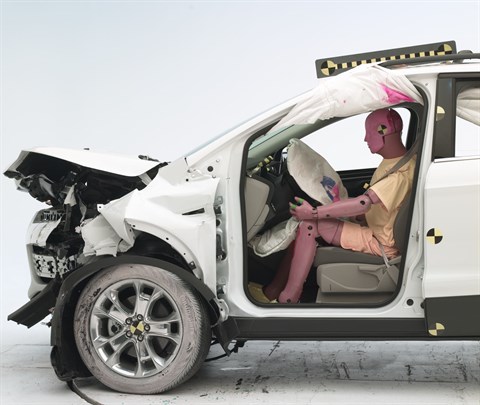
The dummy's position in relation to the steering wheel and instrument panel after the crash test indicates that the driver's survival space was maintained well (Institute test car shown).
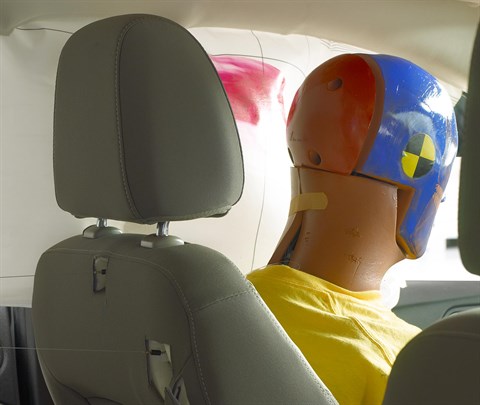
Smeared greasepaint behind the dummy's head shows where the head was protected from hitting hard structures during rebound by the side curtain airbag in the Institute's test.
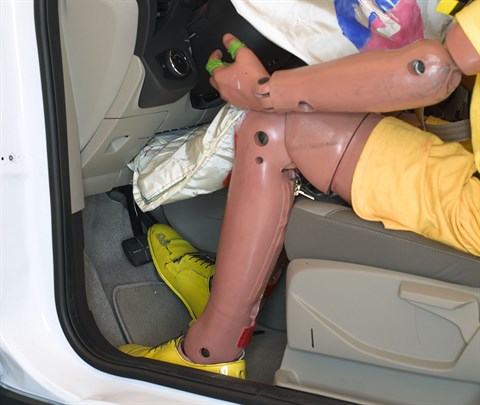
Intrusion into the driver's space was minimal in both tests, and all leg and foot injury measures were low.
Side: original test
Rating applies to 2013-19 models
Tested vehicle: 2013 Ford Escape SE 4-door 4wd with standard front and rear head curtain airbags and standard front seat-mounted torso airbags
The Ford Escape was redesigned for the 2013 model year. Side impact ratings are assigned by the Institute based on a test conducted by Ford.
| Evaluation criteria | Rating |
|---|---|
| Overall evaluation | |
| Structure and safety cage | |
| Driver injury measures | |
| Head/neck | |
| Torso | |
| Pelvis/leg | |
| Driver head protection | |
| Rear passenger injury measures | |
| Head/neck | |
| Torso | |
| Pelvis/leg | |
| Rear passenger head protection | |
Roof strength
Rating applies to 2013-19 models
Tested vehicle: 2013 Ford Escape SE 4-door 4wd
| Overall evaluation | |
|---|---|
| Curb weight | 3,612 lbs |
| Peak force | 18,167 lbs |
| Strength-to-weight ratio | 5.03 |
Head restraints & seats
Seat type: Manual cloth seats
| Overall evaluation | |
|---|---|
| Dynamic rating | |
| Seat/head restraint geometry |
About the head restraint & seat test
Currently, IIHS tests apply only to front seats.
